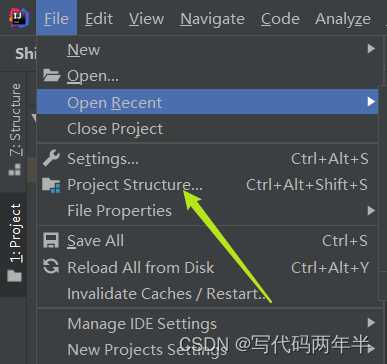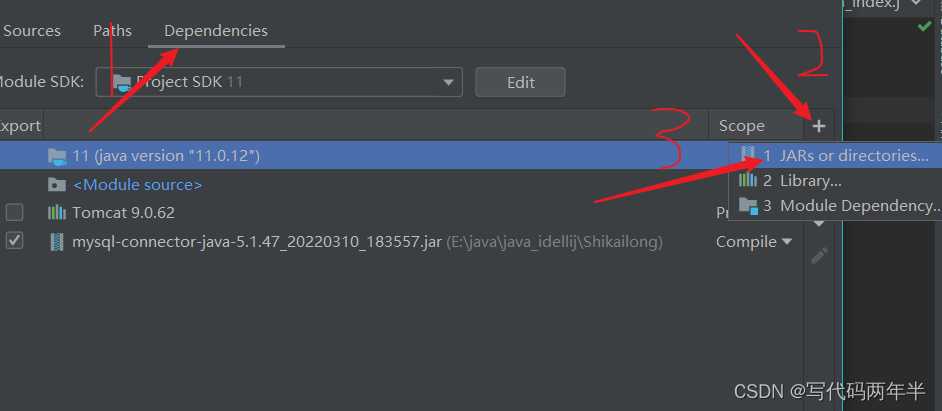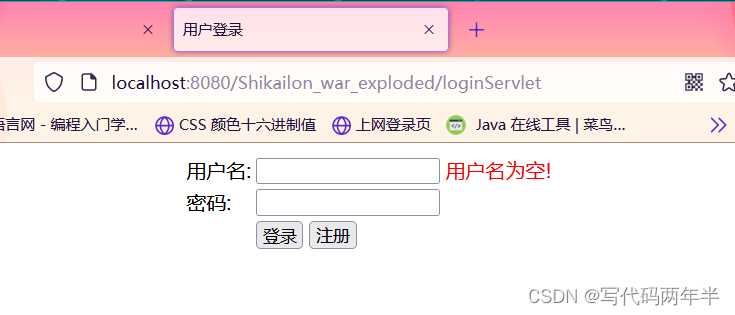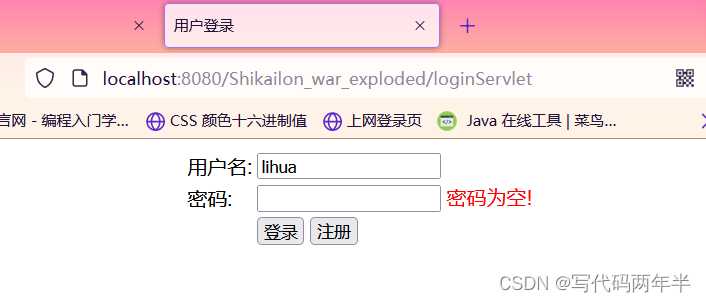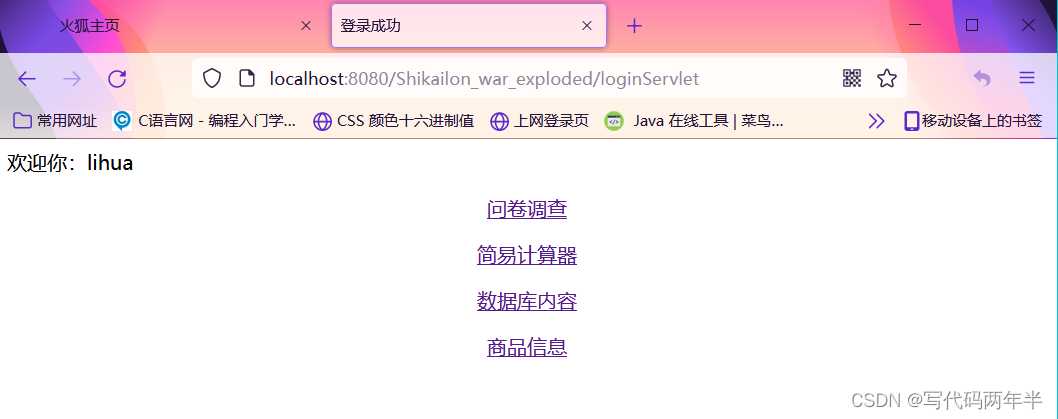目录
前言
众所周知,我们在使用JAVA开发的时候,用户的数据都是存放在数据库当中的,可是市面上有那么多种类的数据库,为了统一各个数据库和java的连接规范,就出现了JDBC。
JDBC的介绍
JDBC为访问不同数据库提供了统一的接口,java程序员使用JDBC,可以连接任何提供JDBC驱动程序的数据库系统,从而完成对数据库的各种操作。
通过JDBC连接MySQL数据库
导入mysql驱动
这个驱动其实就是一个规范接口,需要连接MySQL数据库就下载匹配本机mysql版本的对应驱动,然后导入即可。
连接数据库
连接数据库
String url ="jdbc:mysql://localhost:3306/abc"; //abc为数据库名称
String user = "root"; //定义字符串变量存入mysql登录名
String password = "123456"; //定义字符串存入mysql登录密码
Class.forName("com.mysql.jdbc.Driver"); //加载mysql驱动
Connection connection = DriverManager.getConnection(url,user,password);
Statement statement = connection.createStatement(); //建立连接
判断连接是否成功
if (conn!=null){
out.print("连接成功"+"<br>");
}else{
out.print("连接失败"+"<br>");
}
使用数据库实现登录
获取前端表单的用户输入
String s1=request.getParameter("username");
String s2=request.getParameter("password");
request.setAttribute("s1", s1);
判断用户名和密码为空
//判断用户名、密码是否为空
if(s1 == "" || s1.length() == 0){
request.setAttribute("namemsg","用户名为空!");
request.getRequestDispatcher("index.jsp").forward(request, response);
}
if(s2== "" || s2.length() == 0){
request.setAttribute("pwdmsg","密码为空!");
request.getRequestDispatcher("index.jsp").forward(request, response);
}
查询表
String sql = String.format("SELECT * FROM login WHERE `username` = '%s' AND `password` = '%s'",s1,s2);
ResultSet resultSet = statement.executeQuery(sql);//返回的结果集
判断用户名和密码的匹配
if (resultSet.next()){
request.getRequestDispatcher("login.jsp").forward(request,response); //匹配成功进入登录成功页面
}else if(s1.equals("") || s2.equals("")){
request.getRequestDispatcher("loginf.jsp").forward(request,response); //用户名和密码有一个村务
}else{
request.getRequestDispatcher("loginf.jsp").forward(request,response); //用户和密码全部错误
}
实现整体代码(需要自提,记得点赞)
Servlet代码(loginServlet.java)
package servlet;
import java.io.IOException;
import java.sql.*;
import javax.servlet.ServletException;
import javax.servlet.annotation.WebServlet;
import javax.servlet.http.HttpServlet;
import javax.servlet.http.HttpServletRequest;
import javax.servlet.http.HttpServletResponse;
/** * @author s * @version 1.0 */
@WebServlet("/loginServlet")
public class loginServlet extends HttpServlet {
private static final long serialVersionUID = 1L;
/** * @see HttpServlet#HttpServlet() */
public loginServlet() {
super();
// TODO Auto-generated constructor stub
}
/** * @see HttpServlet#doGet(HttpServletRequest request, HttpServletResponse response) */
protected void doGet(HttpServletRequest request, HttpServletResponse response) throws ServletException, IOException {
doPost(request, response);
}
/** * @see HttpServlet#doPost(HttpServletRequest request, HttpServletResponse response) */
protected void doPost(HttpServletRequest request, HttpServletResponse response) throws ServletException, IOException {
String s1=request.getParameter("username");
String s2=request.getParameter("password");
request.setAttribute("s1", s1);
//判断用户名、密码是否为空
if(s1 == "" || s1.length() == 0){
request.setAttribute("namemsg","用户名为空!");
request.getRequestDispatcher("index.jsp").forward(request, response);
}
if(s2== "" || s2.length() == 0){
request.setAttribute("pwdmsg","密码为空!");
request.getRequestDispatcher("index.jsp").forward(request, response);
}
//密码部分结束
request.setCharacterEncoding("UTF-8");
response.setContentType("text/html");
response.setCharacterEncoding("UTF-8");
//加载mysql驱动
String url ="jdbc:mysql://localhost:3306/abc";
String user = "root";
String password = "123456";
try {
Class.forName("com.mysql.jdbc.Driver");
// 连接数据库
Connection connection = DriverManager.getConnection(url,user,password);
Statement statement = connection.createStatement();
String sql = String.format("SELECT * FROM login WHERE `username` = '%s' AND `password` = '%s'",s1,s2);
ResultSet resultSet = statement.executeQuery(sql);//返回的结果集
if (resultSet.next()){
request.getRequestDispatcher("login.jsp").forward(request,response);
}else if(s1.equals("") || s2.equals("")){
request.getRequestDispatcher("loginf.jsp").forward(request,response);
}
else{
request.getRequestDispatcher("loginf.jsp").forward(request,response);}
}catch(ClassNotFoundException | SQLException e) {
e.printStackTrace();
System.out.println("失败");
}
}
}
jsp代码(index.jsp)
<%--
Created by IntelliJ IDEA.
User: 86151
Date: 2022/5/24
Time: 14:32
To change this template use File | Settings | File Templates.
--%>
<%@ page contentType="text/html;charset=UTF-8" language="java" %>
<%@ page language="java" import="java.util.*" pageEncoding="UTF-8"%>
<%
String path = request.getContextPath();
String basePath = request.getScheme()+"://"+request.getServerName()+":"+request.getServerPort()+path+"/";
%>
<!DOCTYPE HTML PUBLIC "-//W3C//DTD HTML 4.01 Transitional//EN">
<html>
<head>
<base href="<%=basePath%>">
<title>用户登录</title>
<meta http-equiv="pragma" content="no-cache">
<meta http-equiv="cache-control" content="no-cache">
<meta http-equiv="expires" content="0">
<meta http-equiv="keywords" content="keyword1,keyword2,keyword3">
<meta http-equiv="description" content="This is my page">
<!--
<link rel="stylesheet" type="text/css" href="styles.css">
-->
<style type="text/css">
</style>
</head>
<body>
<div>
<form action="loginServlet" method="post">
<table align="center" >
<tr>
<td>用户名:</td>
<td><input type="text" name="username"> <font color="red">
${requestScope.namemsg}${requestScope.nameError}</font></td>
</tr>
<tr>
<td>密码:</td>
<td><input type="password" name="password"> <font color="red">
${requestScope.pwdError}${requestScope.pwdmsg}</font></td>
</tr>
<tr>
<td></td>
<td><input type="submit" value="登录">
<input type="button" value="注册" οnclick='location.href=("registered.jsp")' />
</td>
</tr>
</table>
</form>
</div>
<%--<p align="center">--%>
<%-- <a href="goods_bean_index.jsp">管理员登录</a>--%>
<%--</p>--%>
</body>
</html>
实现效果
登录页面
账号 or 密码 为null
两个账户分别登录成功
登录失败
今天的文章JDBC连接MySQL数据库,访问数据库信息完成登录功能——保姆级详细教程(附所有java和jsp源代码)分享到此就结束了,感谢您的阅读,如果确实帮到您,您可以动动手指转发给其他人。
版权声明:本文内容由互联网用户自发贡献,该文观点仅代表作者本人。本站仅提供信息存储空间服务,不拥有所有权,不承担相关法律责任。如发现本站有涉嫌侵权/违法违规的内容, 请发送邮件至 举报,一经查实,本站将立刻删除。
如需转载请保留出处:https://bianchenghao.cn/32621.html

